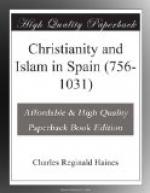[4] See p. 57. Recent history affords a similar instance from the Christian side. See “Gordon in Central Africa,” p. 54—“I have made them make a mosque, and keep the Ramadhan.” Ibid., p. 249, “I had the mosque cleared out and restored for worship, and endowed the priests and crier, and had a great ceremony at the opening of it.... They blessed me and cursed Zebehr Pasha who took the mosque from them. To me it appears that the Mussulman worships God as well as I do, and is as acceptable, if sincere, as any Christian.”
[5] Such as secretary, farmer of taxes, or even prime minister.
Among the great functionaries of state there was one who held the office of Kitabatu-dh-dhimam, which, being interpreted, is “the office of protection.” The Christians and Jews were under his general jurisdiction, and were called “the people of the protection."[1] But besides this Arab “Secretary of State for the Christians,” the latter had their own counts—a relic of the Gothic system—who, however, did not always stand up for their interests.[2] There were also Christian censors,[3] but it is not known what position they held in the State.
The young Christian cadets of noble birth were brought up at Court, and numbers of Sclavonian Christians served in the king’s bodyguard, of whom under Hakem I. (796-822) there were 2000.[4]
[1] Al Makk., i. p. 103; and De Gayangos’ note, p. 398.
[2] E.g.. Servandus. Cp. also Cyprianus.
[3] See above, p. 49.
[4] Conde, i. p. 260.
All things considered, it is a matter for surprise that these two peoples, so unlike in race, habits, prejudices, and religion, lived so comparatively quietly side by side in spite of a perpetual state of warfare between the Arabs and the Christians in the North, which tended to keep alive the animosities of the two races in that part of Spain which was under Mohammedan rule.[1] Moreover, the pride of race was very strong in the pure-blooded Arabs. Thus the poet Said ibn Djoud, in a poem called the “battle of the town” (Polei), boasts that the conquerors are of the pure race of Adnan and Kahtan, without any foreign admixture; while he calls the defeated Spaniards miscreants, followers of a false faith,[2] sons of the pale-faces. The haughty Arabs, in fact, were too prone to look upon all the Spaniards, both renegades and Christians, as mere canaille.[3]
But, in spite of this, the races to a certain extent amalgamated; and Eulogius endeavours to prove that, but for the outbreak of fanaticism in the middle of the ninth century, this amalgamation would have had serious results for Christianity in Spain.[4]
The Arabs did not disdain to seek the alliance of the free Christian States, nor were the latter averse from doing the same, when political occasion demanded it. As early as 798 the Walis of the frontier cities sought to make themselves independent by what the Arab writer describes as “vile policy and unworthy acts,” i.e., by seeking the friendship of the Christian kings;[5] and there are many instances of these kings asking aid, even servilely, from Arab princes.[6]




